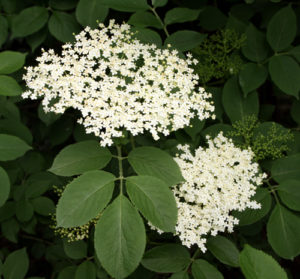LONG REVERED FOR IT’S IMMUNE PROPERTIES, THIS AMAZING PLANT HAS SO MANY USES FOR THE COLD AND FLU SEASON THAT YOU SHOULD PROBABLY PLANT ONE IN YOUR BACK YARD.
The elder tree is one of those plants you should probably have in your backyard. Not only are it’s flowers beautiful, but both the blossoms and the berries are excellent remedies to have on hand for the cold and flu season and are safe for adults and children alike. (3)
While the berries are helpful for both before and during the cold and flu season, the flowers are best saved for those times when you come down with something and need a little help sweating it out. As a diaphoretic herb, these little beauties help open up your pores and increase your core body temperature in a gentle way so that you can sweat out whatever illness is availing you.
Increasing sweating helps to remove toxins from the body and helps to cool you down, making fevers more comfortable.
Elderflower is also anti-inflammatory, anti-catarrhal and expectorant, and helps in cases of colds, sinusitis and sinus allergies to reduce inflammation of sinus tissue and allow for the movement of congestion. Research reviewed by Ulbricht et al. (2014) suggests that “herbal preparations containing elder may result in less swelling of mucus membranes, better drainage, milder headache, and decreased nasal congestion.” (5)

If you do decide to put an elder in your yard or harvest from a wild-growing plant, make sure you get the right kind of elder. Dwarf Elder, Sambucus ebulus, is known to be toxic and should not be used for herbal remedies. American Elder, Sambucus canadensis, is safe for use but is not the standard elder that is studied in clinical trials, though this doesn’t mean it’s not just as good as a remedy.
The best way to know for sure is to have someone positively identify the plant for you, a botanist or an arborist should be able to help. If you decide to plant one in your yard, then make sure you’re getting the right kind of plant from a good nursery that knows what they are doing.
When wild harvesting, always make sure it’s ok to harvest on the land where the plant is located and be very sure you know the area hasn’t been sprayed with any chemicals that you probably don’t want to be ingesting.
Once you’ve got a plant that is safe to harvest from, pick and dry the flowers when they are blooming and save them for later in the year, just make sure to leave some behind so you can get berries later too!
If you don’t have any on hand, you can always get some in the store, or you can go straight to the good stuff and pick up a tin of our Cold & Flu or Fever Buster Tea.
ELDERFLOWER MATERIA MEDICA
Latin Name: Sambucus nigra
Actions:
- Anti-inflammatory
- Antiviral
- Astringent
- Diaphoretic
- Diuretic
- Febrifuge
- Immune Boosting
Uses
Orally, elderflower is used for sinusitis, colds, influenza (flu), swine flu, and bronchitis. It is also used as a mild laxative for constipation, as a diuretic, and as a diaphoretic to help promote sweating.
Topically, elderflower preparations are used as a gargle and mouthwash for coughs, colds, laryngitis, flu, and shortness of breath. It is used on the skin as an astringent for swelling and inflammation.
Ophthalmically, elderflower is used for red itchy eyes.
Preparation & Dosing (3)
- Tea: 1-2 teaspoons flowers per cup boiling water, steeped for 10-15 minutes, taken three times per day.
- Tincture: 2-4 mL (1:5 in 40%) elderflower tincture, taken three times per day.
- Syrup: 2-3 teaspoons elderberry syrup, taken 3-4 times per day.
Cautions:
Elderflower is Generally Recognized as Safe (GRAS) by the FDA (2)
The berries have been known to cause nausea and vomiting if consumed raw, so always cook the berries first (4)
References
- Chevallier, Andrew. (2000). Encyclopedia of Herbal Medicine. London: DK Publishing
- Electronic Code of Federal Regulations. Title 21. Part 182 — Substances Generally Recognized As Safe. Available at: http://ecfr.gpoaccess.gov/cgi/t/text/text-idx?c=ecfr&sid= 786bafc6f6343634fbf79fcdca7061e1&rgn=div5&view= text&node=21:3.0.1.1.13&idno=21
- Hoffman, David. (2003). Medical Herbalism. Rochester, VT: Healing Arts Press
- Natural Medicines Database. Elderflower Professional Monograph. https://naturalmedicines.therapeuticresearch.com/databases/food,-herbs-supplements/professional.aspx?productid=708
- Ulbricht, C, Basch, E, et al. (2014). An evidence-based systematic review of elderberry and elderflower (Sambucus nigra) by the natural standard research collaboration. J Diet Suppl. 2014 Mar;11(1):80-120




